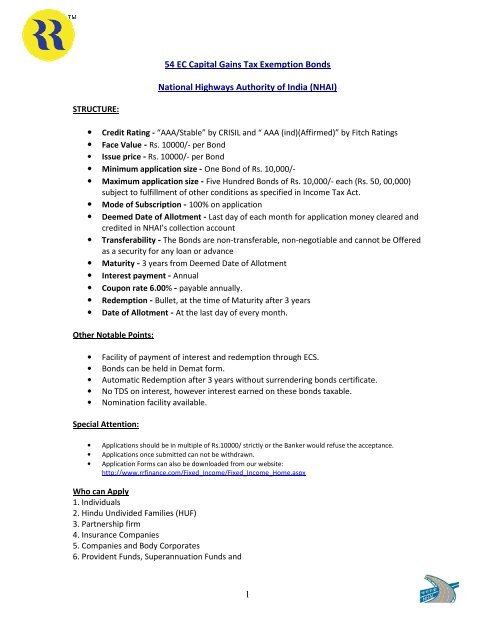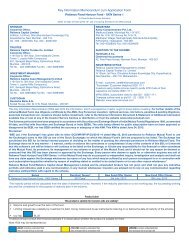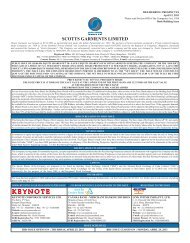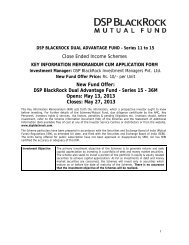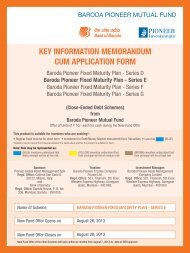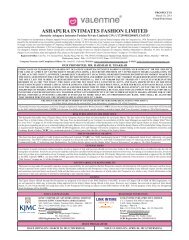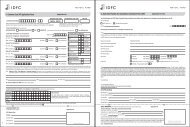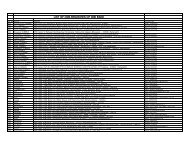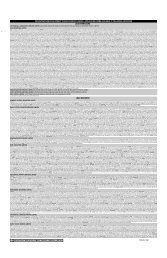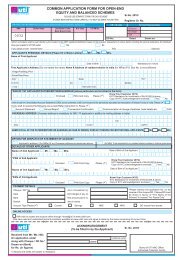1 54 EC Capital Gains Tax Exemption Bonds ... - Rrfinance.com
1 54 EC Capital Gains Tax Exemption Bonds ... - Rrfinance.com
1 54 EC Capital Gains Tax Exemption Bonds ... - Rrfinance.com
You also want an ePaper? Increase the reach of your titles
YUMPU automatically turns print PDFs into web optimized ePapers that Google loves.
<strong>54</strong> <strong>EC</strong> <strong>Capital</strong> <strong>Gains</strong> <strong>Tax</strong> <strong>Exemption</strong> <strong>Bonds</strong>National Highways Authority of India (NHAI)STRUCTURE:• Credit Rating - “AAA/Stable” by CRISIL and “ AAA (ind)(Affirmed)” by Fitch Ratings• Face Value - Rs. 10000/- per Bond• Issue price - Rs. 10000/- per Bond• Minimum application size - One Bond of Rs. 10,000/-• Maximum application size - Five Hundred <strong>Bonds</strong> of Rs. 10,000/- each (Rs. 50, 00,000)subject to fulfillment of other conditions as specified in In<strong>com</strong>e <strong>Tax</strong> Act.• Mode of Subscription - 100% on application• Deemed Date of Allotment - Last day of each month for application money cleared andcredited in NHAI’s collection account• Transferability - The <strong>Bonds</strong> are non-transferable, non-negotiable and cannot be Offeredas a security for any loan or advance• Maturity - 3 years from Deemed Date of Allotment• Interest payment - Annual• Coupon rate 6.00% - payable annually.• Redemption - Bullet, at the time of Maturity after 3 years• Date of Allotment - At the last day of every month.Other Notable Points:• Facility of payment of interest and redemption through <strong>EC</strong>S.• <strong>Bonds</strong> can be held in Demat form.• Automatic Redemption after 3 years without surrendering bonds certificate.• No TDS on interest, however interest earned on these bonds taxable.• Nomination facility available.Special Attention:• Applications should be in multiple of Rs.10000/ strictly or the Banker would refuse the acceptance.• Applications once submitted can not be withdrawn.• Application Forms can also be downloaded from our website:http://www.rrfinance.<strong>com</strong>/Fixed_In<strong>com</strong>e/Fixed_In<strong>com</strong>e_Home.aspxWho can Apply1. Individuals2. Hindu Undivided Families (HUF)3. Partnership firm4. Insurance Companies5. Companies and Body Corporates6. Provident Funds, Superannuation Funds and1
7. Banks8. Mutual Funds9. FIs10. Foreign Institutional Investors (Subject to existing11. RRBs12. NRIs investing out of NRO A/c on non-repatriable13. Co-operative Banks14. Other eligible categoriesDOCUMENTS TO BE PROVIDED BY ALL INVESTORS (including Individuals)1. Self attested copy of PAN Certificate (In case of Joint application, selfattested PAN copy of all the applicants) or Form 60 where bondapplication size is Rs. 50,000/- or more2. Address Proof.3. Photo Copy of cancelled Cheque for N<strong>EC</strong>S facilityDOCUMENTS TO BE PROVIDED BY INVESTORS OTHER THAN INDIVIDUALS (IN ADDITION TOTHE DOCUMENTS TO BE PROVIDED WITH KNOW YOUR CUSTOMER FORM)1) Partnership Firms : A certified true copy of : (i) Documentary evidence ofauthorization to invest in the <strong>Bonds</strong> and to receive the money onredemption, if the same is not provided in the Partnership deed and (ii)Specimen signature of authorized signatories.2) Companies and Body Corporate, Financial Institutions, ForeignInstitutional Investors : A certified true copy of (i) Board resolutionauthorizing investment and containing operating instructions and (ii)Specimen signatures of authorized signatories.3) Banks : A certified true copy of (i) Power of Attorney and (ii) Specimensignatures of authorized signatories.4) Provident Funds, Superannuation Funds and Gratuity Funds : (i)Resolution passed by the <strong>com</strong>petent authority authorizing theinvestment and (ii) Specimen signatures of the authorized signatories.5) Mutual Funds: A certified true copy of (i) SEBI registration certificate; (ii)Resolution passed by the <strong>com</strong>petent authority authorizing theinvestment and containing operating instructions and (iii) Specimensignatures of the authorized signatories.2
PAYMENT ON REDEMPTIONFor bond(s) held in physical Form: The <strong>Bonds</strong> will be automatically redeemed by NHAI on maturity,without the surrender of Bond Certificate(s) by the Bondholder(s), on the expiry of 3 years from thedeemed date of allotment and the redemption proceeds would be paid by cheque or N<strong>EC</strong>S/<strong>EC</strong>S to theBondholder whose name appear in the Register of Bondholders maintained by the Registrar. In case oftransmission applications pending on the record date, the redemption proceeds will be issued to the legalheirs after the confirmation of the adequacy and correctness of the documentation submitted with suchapplication. Till such time, the redemption proceeds will be kept in abeyance.The <strong>Bonds</strong> would stand extinguished from the redemption date. The payment will be made in the name ofBondholder registered as Bondholders as on the record date fixed by the Authority for this purpose i.e. 30days prior to the respective redemption date (“ Record Date”). (The payment of redemption proceedsshall be made in the name of First Applicant (in case of Joint application)/Sole Applicant and as per Bankaccount particulars provided in the Application).For Bond(s) held in Demat Form: On the redemption date, redemption proceeds would be paid byCheque(s)/ Redemption Warrant(s) etc., to those Bondholders whose names appear on the list ofbeneficial owners given by the Depository to the Authority. These names would be as per the depository’srecord on the record Date / book closure date fixed for the purpose of redemption. These <strong>Bonds</strong> will besimultaneously extinguished. It may be noted that in the entire process mentioned above, no action isrequired on the part of the Bondholders.TAXATIONTAX DEDUCTION AT SOURCEThe Ministry of Finance, Department of Revenue, Government of India, has, by notification in the officialGazette on 5th March, 2004 (notification No. 67/2004/F.No. 275/5/2004-IT (B) announced exemptionfrom TDS provisions as follows.“In exercise of the power conferred by clause (ii) (b) of the proviso to Section 193 of the In<strong>com</strong>e <strong>Tax</strong> Act,1961 (43 of 1961), the Central Government hereby specifies the “NHAI Non-convertible Redeemable<strong>Bonds</strong> with benefits under Section <strong>54</strong> <strong>EC</strong> of the In<strong>com</strong>e <strong>Tax</strong> Act, 1961” issued by National HighwaysAuthority of India, New Delhi for the purpose of the said clause.Provided that the benefit under the said clause shall be admissible in the case of transfer of such <strong>Bonds</strong> byendorsement or delivery, only if the transferee informs National Highways Authority of India, New Delhiby registered post within a period of 60 days of such transfer”.TAX BENEFITS UNDER S<strong>EC</strong>TION <strong>54</strong> <strong>EC</strong> OF THE INCOME TAX ACT 1961Section <strong>54</strong> <strong>EC</strong> relating to exemption on long term capital gains if invested in <strong>Bonds</strong> was inserted by theFinance Act 2000 effective for the assessment year 2001-2002 and subsequent years from 1st April, 2001.The section as effective for the assessment year 2008-09 and subsequent years from 1st April, 2007 readsas follows:CAPITAL GAIN NOT TO BE CHARGED ON INVESTMENT IN CERTAIN BONDS1) Where the capital gain arises from the transfer of a long term capital asset, (the capital asset sotransferred being hereafter in this section referred to as the original asset) and the assessee has, at anytime within a period of six months after the date of such transfer, invested the whole or any part ofcapital gains in the long term specified asset, the capital gain shall be dealt with in accordance with thefollowing provisions of this section, that is to say.a) if the cost of the long-term specified asset is not less than the capital gain arising from the transfer ofthe original asset, the whole of such capital gain shall not be charged under section 45;3
) if the cost of the long-term specified asset is less than the capital gain arising from the transfer of theoriginal asset, so much of the capital gain as bears to the whole of the capital gain the same proportion asthe cost of acquisition of the long-term specified asset bears to the whole of the capital gain, shall not becharged under section 45.(Provided that the investment made on or after the 1st day of April, 2007 in the long term specified assetby an assessee during any financial year does not exceed fifty lakhs rupees.2) Where the long-term specified asset is transferred or converted (otherwise than by transfer) intomoney at any time within a period of three years from the date of its acquisition, the amount of capitalgains arising from the transfer of the original asset not charged under section 45 on the basis of the costof such long- term specified asset as provided in clause (a) or, as the case may be, clause (b) of sub-section(1) shall be deemed to be the in<strong>com</strong>e chargeable under the head “<strong>Capital</strong> gains” relating to long-termcapital asset of the previous year in which the long-term specified asset is transferred or converted(otherwise than by transfer) into money.4Website . www.rrfinance.<strong>com</strong> Email: rrinvestors@rrfcl.<strong>com</strong> Call Toll Free: 1800-11-0444www.rrfcl.<strong>com</strong> Disclaimer (For BSNL/MTNL only)


